|
|
GIZE, STONEHENGE, CHICHEN ITZA, ETC,ETC: PIRAMIDES EN ESPANIA, BOLIVIA, SUDAN, COLOMBIA, ETC,ETC
Choisir un autre rubrique de messages |
|
Réponse |
Message 1 de 15 de ce thème |
|
Cuando empecé este articulo me di cuenta que iba a ser muy largo, pero no me imagine la cantidad de información que me iba a encontrar. A manera de resumen les dejo algunas muestras de que algo hay en común por lo menos en el subconsciente del hombre sobre las estructuras piramidales. Vean entonces y encuentren similitudes y diferencias. Aunque cabe aclarar que algunas de estas pirámides tienen diferentes fechas de construcción, unas más modernas que otras, otras en donde todavía hay especulación sobre su fecha de construcción real, (el complejo de Giza, Tiahuanaco) sin embargo lo asombroso es que en diferentes fechas y distancias hay ese deseo colectivo de construir pirámides sobre todo con tintes religiosos. La pirámide representa la estructura de la sociedad a un nivel, a otro nivel significa la deidad. En un sentido matemático y filosófico significan creación al identificarse con el número tres y con el triángulo. Pero aún más allá de todo eso existe una serie de relaciones matemáticas y filosóficas que pienso prepararles en otras entregas. Por otra parte se cree que existió una cultura madre, como la Atlántida, que pudo haber tenido en su centro la gran pirámide de poder. Egipto Definitivamente las mas conocidas y las mas misteriosas y probablemente las mas antiguas. Egipto se relaciona con el misterio y con la esfinge.
Las tabla esmeralda de Hermes Trismegisto tiene una extraña referencia de la esfinge:
“Sobre la nave, erigí una señal en la forma de un león no obstante como un hombre. Ahí debajo de la imagen descansa aún mi nave, para ser traída cuando necesite elevarse.
Sábete, oh hombre, que lejos en el futuro, invasores vendrán de la profundidad. Entonces despierta, tú que tienes sabiduría. Trae mi nave y conquista con facilidad. En lo profundo debajo de la imagen yace mi secreto. Busca y encuentra en la pirámide que construí.”
SudanLa ciudad de Meroe existía desde, al menos, el año 750 a. C., y fue la capital secundaria del reino de Napata, o Kush. Napata fue saqueada por Egipto en 590 a. C. y desde entonces la capital pasó a ser Meroe. Situada en la ribera de una amplia curva del Nilo, en Nubia, entre las montañas etíopes, fue destruida cerca del año 350 d. C. La ciudad esta compuesta de tres zonas:
- La denominada ciudad real rodeada de un muro, donde se encuentra el palacio y los edificios de la corte.
- El complejo de templos de Amani (Amón)
- La ciudad, donde reside la población.
Las pirámides de Meroe. De la ciudad se conservan restos de muralla y de un posible palacio real, algunos templos pequeños y el gran templo de Amón, y santuarios. Los templos están dedicados a dioses egipcios y a dioses nubios. Una necrópolis cerca de la ciudad contiene unas mil tumbas casi todas de túmulos. Una más lejana en Begarawiya, tiene tumbas reales:
- La zona sur (más antigua) contiene hasta 204, entre ellas la pirámide de Arakakamani o Arkamani (Ergamenes) que corresponde al primer rey que se enterró en la ciudad hacia el 260 a. C.
- La zona norte tiene 44 tumbas (37 de ellas de los reyes de Meroe entre 250 a. C. y 320 d. C.)
- El sector oeste con las tumbas de los altos dignatarios.
Las pirámides son pequeñas (la más grande no llega a los veinte m de base). Fueron excavadas de 1909 a 1914, de 1920 a 1923 y de 1974 a 1976
MéxicoEn México hay miles de zonas arqueológicas, muchas de ellas tienen estructuras piramidales. Estos son algunos ejemplos de ellas. Teotihuacan
Teotihuacan ( náhuatl: Teōtihuácān, «Lugar donde fueron hechos los dioses; ciudad de los dioses» ) ?[1] es el nombre dado por los mexicas a los restos de centro urbano antiguo de Mesoamérica anterior a ellos y que alcanzó mayor apogeo durante el periodo Clásico[2] y actualmente una zona arqueológica localizada en el valle del mismo nombre, que forma parte de la Cuenca de México. Dista a unos 45 kilómetros al noreste de la Ciudad de México y forma parte de los municipios de San Juan Teotihuacan y San Martín de las Pirámides, en el noreste del estado de México. Aunque la ciudad llegó a tener una superficie de aproximadamente 21 km 2, en la actualidad el conjunto de monumentos arqueológicos que se encuentra abierto a la visita del público representa aproximadamente la décima parte de la ciudad original. Llegó a contar con una población de entre 150 y 200 mil habitantes en su época de mayor esplendor.
La Tradición de Teuchitlan, Jalisco.Esta región ubicada a 45 km de la ciudad de Guadalajara consiste en estructuras en forma de círculos concéntricos, utilizados para adorar a sus dioses, principalmente a Ehécatl (Dios del Viento). En una vista aérea, se puede apreciar la forma de círculo perfecto de su edificio ceremonial y de sus asentamientos rodeados, en donde se sentaban las familias a ver, y a bailar, para sus dioses elementales (viento, agua, fuego, tierra). En el centro de la estructura circular principal(sus pisos son un calendario exacto de 52 años) existe un largo orificio; allí se ponía un poste, del cual los sacerdotes se sujetaban y se mecían de un lado a otro simulando el vuelo de un ave. Tal tradición era una ofrenda al dios Ehécatl.
OtomíEs muy posible que los ancestros de los otomíes hayan ocupado el centro de México desde hace por lo menos cinco milenios, por lo que habrían participado en el florecimiento de las primeras urbes mesoamericanas.
Mayas La civilización maya habitó una vasta región denominada Mesoamérica, en el territorio hoy comprendido por cinco estados del sureste de México que son, Campeche, Chiapas, Quintana Roo, Tabasco y Yucatán; y en América Central, en los territorios actuales de Belice, Guatemala, Honduras y El Salvador, con una historia de aproximadamente 3.000 años. El Castillo
Guatemala Tikal es la más grande de las antiguas ciudades de los mayas del período clásico. Está situada en la región de Petén, en el territorio actual de Guatemala. Tikal fue uno de los principales centros culturales y poblacionales de la civilización maya. La tumba del posible fundador de la dinastía Yax Ehb' Xook data de ca. año 60, aunque muestra ocupación desde ca. 600 a. C. según hallazgos en Mundo Perdido, la parte más antigua de la ciudad. Prosperó principalmente durante el período clásico maya, aproximadamente de 200 a 850, después del cual no se construyeron monumentos mayores, algunos palacios de la élite fueron quemados, y la población gradualmente decayó hasta que el sitio fue abandonado a finales del siglo X
Bolivia Akapana es una pirámide que se encuentra en las Ruinas Arqueológicas de Tiwanaku, Departamento de La Paz, Bolivia. Está a 70 km de la ciudad de La Paz, en Bolivia. Tiene un perímetro de 800 m y una altura de 18 metros con relación al suelo. Está constituida por 7 terrazas escalonadas sostenidas por muros de contención diferentes para cada nivel, lo cual sugiere un tiempo largo de construcción. Se cree que los tiwancotas lo usaban como lugar de culto, pues en su cima se encuentra un templo al igual que en muchas de las estructura mesoamericanas de su tipo.
Colombia El Morro del Tulcán es el principal sitio arqueológico de Popayán. Este consiste en una pirámide truncada construida en la época precolombina, aproximadamente entre los años 500 – 1600 d.C.; período que se conoce como "de las Sociedades Cacicales Tardías". Sobre ésta pirámide existe hoy una estatua dedicada al Conquistador Sebastián de Belalcázar, quien llevó a cabo la fundación hispánica de Popayán. China Hay construcciones piramidales en China (como la enorme pirámide blanca o la pirámide de Zangkunchong),
Japón En Japón (restos sumergidos de Yonagun
EspañaLas Pirámides de Güímar o Majanos de Chacona se encuentran en el municipio de Güímar en la costa sureste de la isla de Tenerife, en el archipiélago de las Islas Canarias, en España. Se encuentran a unos 26 kilómetros de la ciudad de Santa Cruz de Tenerife. Tiene categoría de Bien de Interés Cultural. Son cinco construcciones en forma de pirámides escalonadas orientadas astronómicamente. El Parque Etnográfico Pirámides de Güímar ofrece al visitante la posibilidad de contemplar estas construcciones escalonadas.
Indonesia
Borobudur (en javanés barabudhur o barabudur) es una estupa budista con silueta piramidiforme relacionada con la tradición Mahāyāna, y es el monumento budista más grande del mundo. Está ubicado en la provincia Java Central de Indonesia, 40 kilómetros al noroeste de Yogyakarta. Fue construido entre los años 750 y 850 por los soberanos de la dinastía Sailendra. El nombre puede derivar del sánscrito " Vihara Buddha Ur", que se traduce como "el templo budista en la montaña".
Templo de Besakih. Según las creencias tradicionales del pueblo balinés, cuando los dioses descienden a la tierra se alojan en este templo, el más venerado de la isla. De entre las más de cincuenta ceremonias religiosas que tienen lugar en él cada año, la principal es la de Betara Turun Kabeh, cuando "todo los dioses descienden a la tierra".
Candi Sukuh (Indonesia Pronunciación: [sʊkʊh tʃandi]) es un siglo 15 javanés-templo hindú (candidatos) que se encuentra en la ladera occidental del monte Lawu (Elev. 910 metros o 3.000 pies (910 m) sobre el nivel del mar) en el frontera entre la central y las provincias de Java Oriental. Candi Sukuh tiene relieves distintivos temáticos de otros candidatos donde la vida antes del nacimiento y la educación sexual son su tema principal. Su principal monumento es una estructura simple pirámide con relieves y estatuas en frente de ella, incluyendo a tres tortugas de concha plana y una figura masculina agarrar su pene. Un gigante de 1.82 m (6 pies) de altura de Lingga (falo) con cuatro bolas, en representación de las incisiones del pene, [1] fue una de las estatuas que se ha trasladado al Museo Nacional de Indonesia. Otras Referencias Extrañas
La cueva de los tayos En la Cueva de los tayos en ecuador se encontraron misteriosas tablillas con algunas referencias graficas a las pirámides
Otras referencias culturales
Palacio de la Paz y la ReconciliaciónLa pirámide fue construida especialmente para acoger el Congreso de Dirigentes de Religiones Mundiales y Tradicionales. Una sede de 1.500 óperas se basa en los niveles inferiores, con el auditorio y el rendimiento del diseño del equipo por Anne Minors Performance Consultants y rendimiento de sonido por la acústica de Sound Space Design.
La Pirámide del Museo del Louvre es una obra situada en el patio del Museo del Louvre, en París, que da acceso al edificio. Fue diseñada por el arquitecto Ieoh Ming Pei. De estilo internacional, esta pirámide de vidrio y aluminio fue inaugurada en el año 1989 por el entonces presidente francés, François Mitterrand. Tiene una altura de 21,6 m y un total de 673 paneles de vidrio laminado transparente divididos en 603 rombos y 70 triángulos. [1] El peso total de la estructura es de 180 toneladas. La inclinación de sus paredes, al igual que ocurre con las pirámides egipcias, es de 51º.
En la serie Stargate, la Nave Pirámide Clase Ha'tak es el modelo más típico de naves de batalla Goa'uld. Son las naves de guerra primarias de las flotas de los Señores del Sistema. Con capacidad para transportar 1.000 Jaffas. Lo cierto es que el hombre por diversas razones ha estado fascinado con las pirámides, son la cuna del misterio
|
|
|
 Premier
Premier
 Précédent
2 à 15 de 15
Suivant
Précédent
2 à 15 de 15
Suivant
 Dernier
Dernier

|
|
Réponse |
Message 3 de 15 de ce thème |
|
|
|
|
Réponse |
Message 4 de 15 de ce thème |
|
Pyramid
From Wikipedia, the free encyclopedia
A pyramid (from Greek: πυραμίς pyramis[1]) is a structure whose shape is roughly that of a pyramid in the geometric sense; that is, its outer surfaces are triangular and converge to a single point at the top. The base of a pyramid can be trilateral, quadrilateral, or any polygon shape, meaning that a pyramid has at least three outer triangular surfaces (at least four faces including the base). The square pyramid, with square base and four triangular outer surfaces, is a common version.
A pyramid's design, with the majority of the weight closer to the ground,[2] and with the pyramidion on top means that less material higher up on the pyramid will be pushing down from above. This distribution of weight allowed early civilizations to create stable monumental structures.
Pyramids have been built by civilizations in many parts of the world. For thousands of years, the largest structures on Earth were pyramids—first the Red Pyramid in the Dashur Necropolis and then the Great Pyramid of Khufu, both of Egypt, the latter the only one of the Seven Wonders of the Ancient World still remaining. Khufu's Pyramid is built mainly of limestone (with large red granite blocks used in some interior chambers), and is considered an architectural masterpiece. It contains around 1,300,000 blocks ranging in weight from 2.5 tonnes (5,500 lb) to 15 tonnes (33,000 lb) and is built on a square base with sides measuring about 230 m (755 ft), covering 13 acres. Its four sides face the four cardinal points precisely and it has an angle of 52 degrees. The original height of the Pyramid was 146.5 m (488 ft), but today it is only 137 m (455 ft) high, the 9 m (33 ft) that is missing is due to the theft of the fine quality white Tura limestone covering, or casing stones, for construction in Cairo. It is still the tallest pyramid. The largest pyramid by volume is the Great Pyramid of Cholula, in the Mexican state of Puebla.
Ancient monuments [edit]
Mesopotamia [edit]

Chogha Zanbil is an ancient Elamite complex in the Khuzestan province of Iran.
The Mesopotamians built the earliest pyramidal structures, called ziggurats. In ancient times, these were brightly painted. Since they were constructed of sun-dried mud-brick, little remains of them. Ziggurats were built by the Sumerians, Babylonians, Elamites, Akkadians, and Assyrians for local religions. Each ziggurat was part of a temple complex which included other buildings. The precursors of the ziggurat were raised platforms that date from the Ubaid period[3] during the fourth millennium BCE. The earliest ziggurats began near the end of the Early Dynastic Period.[4] The latest Mesopotamian ziggurats date from the 6th century BCE. Built in receding tiers upon a rectangular, oval, or square platform, the ziggurat was a pyramidal structure with a flat top. Sun-baked bricks made up the core of the ziggurat with facings of fired bricks on the outside. The facings were often glazed in different colors and may have had astrological significance. Kings sometimes had their names engraved on these glazed bricks. The number of tiers ranged from two to seven. It is assumed that they had shrines at the top, but there is no archaeological evidence for this and the only textual evidence is from Herodotus.[5] Access to the shrine would have been by a series of ramps on one side of the ziggurat or by a spiral ramp from base to summit. The Mesopotamian ziggurats were not places for public worship or ceremonies. They were believed to be dwelling places for the gods and each city had its own patron god. Only priests were permitted on the ziggurat or in the rooms at its base, and it was their responsibility to care for the gods and attend to their needs. The priests were very powerful members of Sumerian society.
http://en.wikipedia.org/wiki/Pyramid
|
|
|
|
Réponse |
Message 5 de 15 de ce thème |
|
|
The most famous pyramids are the Egyptian pyramids — huge structures built of brick or stone, some of which are among the world's largest constructions. They are shaped as a reference to the rays of the sun. Most pyramids had a polished, highly reflective white limestone surface, in order to give them a shining appearance when viewed from a distance. The capstone was usually made of hard stone - granite or basalt - and could be plated with gold, silver, or electrum and would also be highly reflective.[6]
After 2700 BCE, the Egyptians began building pyramids, until about 1700 BCE. The first pyramid was built during the Third Dynasty by king Djoser and his architect Imhotep, as a step pyramid by stacking six mastabas. The largest Egyptian pyramids are the pyramids at Giza. "The Egyptian sun god Ra, considered the father of all pharaohs, was said to have created himself from a pyramid-shaped mound of earth before creating all other gods. The pyramid’s shape is thought to have symbolized the sun’s rays" (Donald B. Redford, Ph.D., Penn State).[6]
The age of the pyramids reached its zenith at Giza in 2575-2150 BCE.[7] Ancient Egyptian pyramids were in most cases placed western of the river Nile because the divine pharaoh’s soul was meant to join with the sun during its descent before continuing with the sun in its eternal round.[6]
As of 2008, some 135 pyramids have been discovered in Egypt.[8][9] The Great Pyramid of Giza is the largest in Egypt and one of the largest in the world. Until Lincoln Cathedral was finished in CE 1311, it was the tallest building in the world. The base is over 52,600 square metres (566,000 sq ft) in area. While pyramids are associated with Egypt, the nation of Sudan has 220 extant pyramids, the most numerous in the world.[10]
The Great Pyramid of Giza is one of the Seven Wonders of the Ancient World. It is the only one to survive into modern times. The Ancient Egyptians covered the faces of pyramids with polished white limestone, containing great quantities of fossilized seashells.[11] Many of the facing stones have fallen or have been removed and used for construction in Cairo.
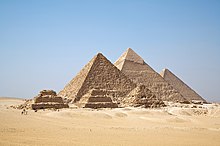
The ancient pyramids of Egypt
Most pyramids are located near Cairo, with only one royal pyramid being located south of Cairo, at the Abydos temple complex. The pyramid at Abydos, Egypt were commissioned by Ahmose I who founded the 18th Dynasty and the New Kingdom.[12]
The building of pyramids began in the Third Dynasty with the reign of King Djoser.[13] Early kings such as Snefru built several pyramids, with subsequent kings adding to the number of pyramids until the end of the Middle Kingdom. The last king to build royal pyramids was Ahmose,[14] with later kings hiding their tombs in the hills, like in the Valley of the Kings in Luxor's West Bank.[15]
In Medinat Habu, or Deir el-Medina, smaller pyramids were built by individuals. Smaller pyramids were also built by the Nubians who ruled Egypt in the Late Period, though their pyramids had steeper sides.[16]

Nubian Pyramids at Meroe with pylon-like entrances.
Nubian pyramids were constructed (roughly 220 of them) at three sites in Sudan to serve as tombs for the kings and queens of Napata and Meroë. The pyramids of Kush, also known as Nubian Pyramids, have different characteristics than the pyramids of Egypt. The Nubian pyramids were constructed at a steeper angle than Egyptian ones. They were monuments to dead kings and queens.[17] Pyramids were still being built in Sudan as late as CE 300.
Nigeria [edit]
One of the unique structures of Igbo culture was the Nsude Pyramids, at the Nigerian town of Nsude, in Abuja, northern Igboland. Ten pyramidal structures were built of clay/mud. The first base section was 60 ft. in circumference and 3 ft. in height. The next stack was 45 ft. in circumference. Circular stacks continued, till it reached the top. The structures were temples for the god Ala/Uto, who was believed to reside at the top. A stick was placed at the top to represent the god's residence. The structures were laid in groups of five parallel to each other. Because it was built of clay/mud like the Deffufa of Nubia, time has taken its toll requiring periodic reconstruction.[18]
Greece [edit]
Main article: Greek pyramids
Pausanias (2nd century CE) mentions two buildings resembling pyramids, one, 19 kilometres (12 mi) southwest of the still standing structure at Hellenikon,[19] a common tomb for soldiers who died in a legendary struggle for the throne of Argos and another which he was told was the tomb of Argives killed in a battle around 669/8 BCE. Neither of these still survive and there is no evidence that they resembled Egyptian pyramids.
There are also at least two surviving pyramid-like structures still available to study, one at Hellenikon and the other at Ligourio/Ligurio, a village near the ancient theatre Epidaurus. These buildings were not constructed in the same manner as the pyramids in Egypt. They do have inwardly sloping walls but other than those there is no obvious resemblance to Egyptian pyramids. They had large central rooms (unlike Egyptian pyramids) and the Hellenikon structure is rectangular rather than square, 12.5 by 14 metres (41 by 46 ft) which means that the sides could not have met at a point.[20] The stone used to build the pyramids was limestone quarried locally and was cut to fit, not into freestanding blocks like the Great Pyramid of Giza.
There are no remains or graves in or near the structures. Instead, the rooms that the walls housed were made to be locked from the inside. This coupled with the platform roof, means that one of the functions these structures could have served was as watchtowers. Another possibility for the buildings is that they are shrines to heroes and soldiers of ancient times, but the lock on the inside makes no sense for such a purpose.
The dating of these "pyramids" has been made from the pot shards excavated from the floor and on the grounds. The latest dates available from scientific dating have been estimated around the 5th and 4th centuries. Normally this technique is used for dating pottery, but here researchers have used it to try to date stone flakes from the walls of the structures. This has created some debate about whether or not these "pyramids" are actually older than Egypt, which is part of the Black Athena controversy.[21] The basis for their use of thermoluminescence in order to date these structures is a new method of collecting samples for testing. Scientists from laboratories hired out by the recent excavators of the site, The Academy of Athens, say that they can use the electrons trapped on the inner surface of the stones to positively identify the date that the stones were quarried and put together[citation needed].
Mary Lefkowitz has criticised this research. She suggests that some of the research was done not to determine the reliability of the dating method, as was suggested, but to back up an assumption of age and to make certain points about pyramids and Greek civilization. She notes that not only are the results not very precise, but that other structures mentioned in the research are not in fact pyramids, e.g. a tomb alleged to be the tomb of Amphion and Zethus near Thebes, a structure at Stylidha (Thessaly) which is just a long wall, etc. She also notes the possibility that the stones that were dated might have been recycled from earlier constructions. She also notes that earlier research from the 1930s, confirmed in the 1980s by Fracchia was ignored. She argues that they undertook their research using a novel and previously untested methodology in order to confirm a predetermined theory about the age of these structures.[22]
Liritzis responded in a journal article published in 2011, stating that Lefkowitz failed to understand and misinterpreted the methodology.[23]
The Pyramids of Güímar refer to six rectangular pyramid-shaped, terraced structures, built from lava stone without the use of mortar. They are located in the district of Chacona, part of the town of Güímar on the island of Tenerife in the Canary Islands. The structures have been dated to the 19th century and their original function explained as a byproduct of contemporary agricultural techniques.
Local traditions as well as surviving images indicate that similar structures (also known as, "Morras", "Majanos", "Molleros", or "Paredones") could once have been found in many locations on the island. However, over time they have been dismantled and used as a cheap building material. In Güímar itself there were nine pyramids, only six of which survive.
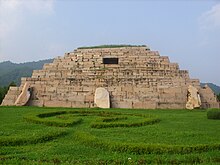
Ancient Korean tomb in Ji'an, Northeastern China
There are many square flat-topped mound tombs in China. The First Emperor Qin Shi Huang (circa 221 BCE, who unified the 7 pre-Imperial Kingdoms) was buried under a large mound outside modern day Xi'an. In the following centuries about a dozen more Han Dynasty royals were also buried under flat-topped pyramidal earthworks.
Mesoamerica [edit]
A number of Mesoamerican cultures also built pyramid-shaped structures. Mesoamerican pyramids were usually stepped, with temples on top, more similar to the Mesopotamian ziggurat than the Egyptian pyramid.
The largest pyramid by volume is the Great Pyramid of Cholula, in the Mexican state of Puebla. Constructed from the 3rd century BCE to the 9th century CE, this pyramid is considered the largest monument ever constructed anywhere in the world, and is still being excavated. The third largest pyramid in the world, the Pyramid of the Sun, at Teotihuacan is also located in Mexico. There is an unusual pyramid with a circular plan at the site of Cuicuilco, now inside Mexico City and mostly covered with lava from an eruption of the Xitle Volcano in the 1st century BCE. There are several circular stepped pyramids called Guachimontones in Teuchitlán, Jalisco as well.
Pyramids in Mexico were often used as places of human sacrifice. For the re-consecration of Great Pyramid of Tenochtitlan in 1487, the Aztecs reported that they sacrificed about 80,400 people over the course of four days.[24] |
|
|
|
Réponse |
Message 6 de 15 de ce thème |
|
North America [edit]
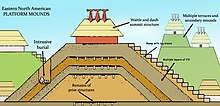
A diagram showing the various components of Eastern North American platform mounds
Many pre-Columbian Native American societies of ancient North America built large pyramidal earth structures known as platform mounds. Among the largest and best-known of these structures is Monks Mound at the site of Cahokia, completed around 1100 CE, which has a base larger than that of the Great Pyramid at Giza. Many of the mounds underwent multiple episodes of mound construction at periodic intervals, some becoming quite large. They are believed to have played a central role in the mound-building peoples' religious life and documented uses include semi-public chief's house platforms, public temple platforms, mortuary platforms, charnel house platforms, earth lodge/town house platforms, residence platforms, square ground and rotunda platforms, and dance platforms.[25][26][27] Cultures who built substructure mounds include the Troyville culture, Coles Creek culture, Plaquemine culture and Mississippian cultures.
Roman Empire [edit]
The 27-metre-high Pyramid of Cestius was built by the end of the 1st century BCE and still exists today, close to the Porta San Paolo. Another one, named Meta Romuli, standing in the Ager Vaticanus (today's Borgo), was destroyed at the end of the 15th century.
There is also a Roman era pyramid built in Falicon, France.[28] There were many more pyramids built in France in this period.
Medieval Europe [edit]
Pyramids have occasionally been used in Christian architecture of the feudal era, e.g. as the tower of Oviedo's Gothic Cathedral of San Salvador.

The main gopura of the Thanjavur Temple pyramid.
Many giant granite temple pyramids were made in South India during the Chola Empire, many of which are still in religious use today. Examples of such pyramid temples include Brihadisvara Temple at Thanjavur, the Temple of Gangaikondacholapuram and the Airavatesvara Temple at Darasuram. However the largest temple pyramid in the area is Sri Rangam in Srirangam, Tamil Nadu. The Thanjavur temple was built by Raja raja Chola in 11th century. The Brihadisvara Temple was declared by UNESCO as a World Heritage Site in 1987; the Temple of Gangaikondacholapuram and the Airavatesvara Temple at Darasuram were added as extensions to the site in 2004.[29]
Indonesia [edit]
Next to menhir, stone table, and stone statue; Austronesian megalithic culture in Indonesia also featured earth and stone step pyramid structures called Punden Berundak as discovered in Pangguyangan, Cisolok and Gunung Padang, West Java. The construction of stone pyramids is based on the native beliefs that mountains and high places are the abode for the spirit of the ancestors.
The step pyramid is the basic design of 8th century Borobudur Buddhist monument in Central Java. However the later temples built in Java were influenced by Indian Hindu architecture, as displayed by the towering spires of Prambanan temple. In the 15th century Java during late Majapahit period saw the revival of Austronesian indigenous elements as displayed by Sukuh temple that somewhat resemble Mesoamerican pyramid.
Modern pyramids [edit]
- The Louvre Pyramid in Paris, France, in the court of the Louvre Museum, is a 20.6 meter (about 70 foot) glass structure which acts as an entrance to the museum. It was designed by the American architect I. M. Pei and completed in 1989.
- The Luxor Hotel in Las Vegas, United States, is a 30-story true pyramid with light beaming from the top.
- The 32-story Pyramid Arena in Memphis, Tennessee (a city named after the ancient Egyptian capital whose name itself was derived from the name of one of its pyramids). Built in 1991, it was the home court for the University of Memphis men's basketball program, and the National Basketball Association's Memphis Grizzlies until 2004.
- The Walter Pyramid, home of the basketball and volleyball teams of the California State University, Long Beach, campus in California, United States, is an 18-story-tall blue true pyramid.
- The 48-story Transamerica Pyramid in San Francisco, California, designed by William Pereira, one of the city's symbols.
- The 105-story Ryugyong Hotel in Pyongyang, Northern Korea.
- A former museum/monument in Tirana, Albania is commonly known as the "Pyramid of Tirana." It differs from typical pyramids in having a radial rather than square or rectangular shape, and gently sloped sides that make it short in comparison to the size of its base.
- The Slovak Radio Building in Bratislava, Slovakia. This building is shaped like an inverted pyramid.
- The Summum Pyramid, a 3 story pyramid in Salt Lake City, Utah, used for instruction in the Summum philosophy and conducting rites associated with Modern Mummification.
- The Palace of Peace and Reconciliation in Astana, Kazakhstan.
- The Pyramids at Osho Commune in Pune, India (for meditation purposes).
- The three pyramids of Moody Gardens in Galveston, Texas.
- The Co-Op Bank Pyramid or Stockport Pyramid in Stockport, England is a large pyramid-shaped office block in Stockport in England. (The surrounding part of the valley of the upper Mersey has sometimes been called the "Kings Valley" after the Valley of the Kings in Egypt.)
- The Ames Monument in southeastern Wyoming honoring the brothers who financed the Union Pacific Railroad.
- The Ballandean Pyramid, at Ballandean in rural Queensland is a 15 meter folly pyramid made from blocks of local granite.
- The Karlsruhe Pyramid is a pyramid made of red sandstone, located in the centre of the market square of Karlsruhe, Germany. It was erected in the years 1823–1825 over the vault of the city's founder, Margrave Charles III William (1679–1738).
- The GoJa Music Hall in Prague.
- The Muttart Conservatory greenhouses in Edmonton, Alberta.
- Small pyramids similar to those of the Louvre can be found outside the lobby of the Citicorp Building in Long Island City, Queens NY.
- The Pyramids of the City Stars Complex in Cairo, Egypt.
- Pyramid building belonging to The Digital Group (TDG), at Hinjwadi, Pune, India.[30]
- The Steelcase Corporate Development Center near Grand Rapids, Michigan.
- Sunway Pyramid shopping mall in Selangor, Malaysia.
- Hanoi Museum with an overall design of a reversed Pyramid.
- The Pyramide des Ha! Ha! by artist Jean-Jules Soucy fr:Jean-Jules Soucy in La Baie, Quebec is made out of 3 000 give way signs.[31]
- The "Pyramid" culture-entertainment complex and Monument of Kazan siege (Church of Image of Edessa) in Kazan, Russia.
- The "Phorum" of Expocentre business-exhibition complex in Moscow, Russia.
- Few pyramids of the Marco-city shopping-entertainment complex in Vitebsk, Belarus.[32]
- The Time pyramid in Wemding, Germany, a pyramid begun in 1993 and scheduled for completion in the year 3183.[33]
- Triangle, a proposed skyscraper in Paris.
- The Shimizu Mega-City Pyramid, a proposed project for construction of a massive pyramid over Tokyo Bay in Japan.
- The tomb of Quintino Sella, outside the monumental cemetery of Oropa.[34][dead link]
Gallery [edit]
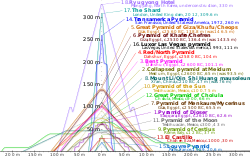
Comparison of approximate profiles of Pyramid with some notable pyramidal or near-pyramidal buildings. Dotted lines indicate original heights, where data is available.
-
-
-
-
-
-
-
-
-
-
-
Monument of Kazan siege (Church of Image of Edessa) in Kazan, Russia.
-
"Pyramid" culture-entertainment complex in Kazan, Russia.
See also [edit]
|
|
|
|
Réponse |
Message 7 de 15 de ce thème |
|
Pirámide de La Danta
De Wikipedia, la enciclopedia libre
(Redirigido desde « Pirámide La Danta») La Pirámide de La Danta es una pirámide construida por los antiguos mayas que se encuentra en El Mirador, Petén, Guatemala, cerca de la frontera con México. Se cree que los inicios de esta construcción pueden remontarse al 300 a. C.[1]
La construcción está compuesta de una gran plataforma de 320 x 600 m, sobre la que se elevan una serie de construcciones piramidales que en su punto más alto alcanzan los 72 m de altura.[1] . El volumen del conjunto, pirámide más plataforma, se estima en 2.800.000 m³ (unos 200.000 m³ más que la Gran Pirámide de Keops en Guiza, Egipto).
La palabra "danta" significa tapir: el animal más grande que poblaba la selva.[2] Al igual que toda la antigua ciudad, esta enorme estructura yace oculta en la selva.
Se calcula que el volumen total de la construcción ronda los 2,800.000 m³,[2] superando por 200.000 m³ a la Gran Pirámide de Keops en Guiza, Egipto. No obstante, se desconoce si la estructura se construyó en llano o aprovechó alguna colina natural; una costumbre común en otras pirámides mesoamericanas. Por altura es la pirámide más alta de América,[3] superando al Templo de la Serpiente Bicéfala en Tikal (Guatemala), de 64 metros.[4]
La magnificencia de este templo precolombino y otros descubrimientos recientes en la Cuenca del Mirador demuestran la cultura altamente sofisticada existente en el preclásico maya, al contrario de la opinión generalmente aceptada hasta la fecha.[5]
Richard D. Hansen cree que la ciudad de El Mirador, donde actualmente se halla la gigantesca edificación, fue la capital del mítico Reino de Kan (Reino de la Serpiente).[6]
En 2011 prosiguen las excavaciones arqueológicas para despojarla del manto de tierra y vegetación que la mantenía oculta.
Referencias [editar]
Enlaces externos [editar]
http://es.wikipedia.org/wiki/Pir%C3%A1mide_La_Danta |
|
|
|
Réponse |
Message 8 de 15 de ce thème |
|
Pyramids of Güímar
From Wikipedia, the free encyclopedia
The Pyramids of Güímar refer to six rectangular pyramid-shaped, terraced structures, built from lava stone without the use of mortar. They are located in the district of Chacona, part of the town of Güímar on the island of Tenerife in the Canary Islands. There are claims that the structures have been dated to the 19th century and their original function explained as a byproduct of contemporary agricultural techniques. However, results of excavations have so far proved inconclusive.
Other pyramids employing the same methods and materials of construction can be found in various sites on Tenerife. In Güímar itself there were nine pyramids, only six of which survive.
Research history [edit]
Thor Heyerdahl [edit]
In 1990, adventurer and publisher, Thor Heyerdahl, became aware of the "Canarian Pyramids" by reading an article written by Francisco Padrón in the Tenerife newspaper "Diario de Avisos" detailing "real pyramids on the Canaries".[1] As Heyerdahl had hypothesized a transatlantic link between Egypt and Central America, he became intrigued by the Güímar pyramids and relocated to Tenerife. There Heyerdahl researched possible parallels between the Canarian terrace structures and pyramid structures in Egypt and Central America in pre-Columbian Mesoamerica as ceremonial areas.
Heyerdahl hypothesised that the Canarian pyramids formed a temporal and geographic stopping point on voyages between ancient Egypt and the Maya civilization, initiating a controversy in which historians, esoterics, archaeologists, astronomers, and those with a general interest in history took part.[2][3]
Astronomical research and Freemasonry [edit]
In 1991, research by Juan Antonio Belmonte Avilés, Antonio Aparicio Juan and César Esteban López, researchers of the Canary Institute of Astrophysics, shown that the long sides of some of the terrace structures at Güímar marked the direction of both solstices. The main limiting wall points to the sunset in the Summer solstice and the pyramids have stairs on their western side which face the direction of the rising sun on the Winter solstice. Also, standing on the platform of the largest pyramid on the day of the Summer solstice it is possible to experience a double sunset, as first the sun sets behind a mountain top, then it emerges again from behind the mountain and sets a second time behind a neighbouring peak.[4] However, considering the room for interpretation, it is impossible based solely on these observations to conclude what was the intention of the builders or the building date.[5]
In 2005, a book was published in Spanish by Aparicio and Esteban titled The Pyramids of Güímar: Myth and Reality. Aparicio and Esteban suggest that the solstitial orientations of the pyramids were potentially motivated by the Freemasons symbolism. These authors argue that solstices are very important in the symbolism of Freemasonry and that the owner of the land in the epoch in which the pyramids were built was himself a freemason. This motivation would be only an aesthetic one and would not modify in any rate the fundamental motivation (agriculture) and date of construction.
Archaeological excavations [edit]
Between 1991 and 1998, with the agreement of Thor Heyerdahl, multiple excavations of the site by archaeologists of the University of La Laguna (Departamento de Prehistoria, Antropología e Historia Antigua) took place. In 1996 the results of the 1991 excavation were presented at a colloquium and in 1998 Session published the inconclusive proof delivered by the dating of the pyramids.[6] According to the preceding geophysical Georadar-Survey eight locations adjacent to the pyramids, each with an area of 25 m², were investigated in layers down to the solid lava-floor. In doing so it was possible to establish three specific sediment layers. Starting from the top these were:
- 1) A layer of thickness averaging 20 cm, consisting of humus-rich earth with many plant remains and roots; tracks from ploughing were clearly identifiable as were a broad spectrum of readily datable finds from the second half of the 20th century.
2) A layer of thickness averaging 25 cm, similar in composition to the first layer, however containing less humus and a larger amount of small stones; a large variety of finds which could be dated to the 19th and 20th century were found, of which an official seal from 1848 deserves particular mention.
3) A layer of thickness between 25 and 150 cm, composed out of small volcanic rocks, most likely put in place in one movement, which levelled the uneven stone underneath; the stones contained only very few finds, mostly a small number of pottery shards, of which some was local and some imported, both kinds were roughly estimated as belonging to the 19th century; however, the ground directly beneath the pyramids themselves have yet to be excavated.
Furthermore, under the border edge of one of the pyramids a natural lava cave was discovered, which had been walled up and gave up finds from the time of the Guanches. Since the pyramids lie stratigraphically above the cave, the Guanche finds from between 600 and 1000 AD can only support conclusions on the date of human use of the cave.
Conclusions [edit]
The archaeologists involved maintain that the creation of the terrace structures followed from the practices of the 19th century rural population, who created these structures while clearing cultivatable land of stones, as they piled the stones into these terrace shapes. The excavations and subsequent research support a date for the construction of the structures no earlier than the 19th century.
Heyerdahl suggested that the structures were not haphazardly piled-up stones. Heyerdahl maintained a belief in the hypothesis that the pyramids were connected with Guanches until his death. The association of the Guanches and the pyramids continues to be elaborated upon both in "Pyramid park" and on its official website.
Aparicio and Esteban's theory connects the facts that the pyramids were built in the 19th century with the acknowledgement that they are not simply piles of stones.
Ethnographic park [edit]
Following the completion of the excavations in 1998, the 65,000 m² area surrounding the pyramids was made accessible to the public. Heyerdahl received financial support from his friend the Canarian businessman Fred Olsen, who owns the largest transport company in the Canaries and whose family came to the islands from Norway in the 20th century. An information centre provides visitors with information about Heyerdahl’s research trips and his previous ideas regarding the pyramids. Two pavilions contain exhibits relating to Heyerdahl along with models of his boats; a replica of the Ra II in its original size, amongst others. In spite of the conclusions regarding the age of the pyramids outlined above, Heyerdahl continued to maintain a belief "in a possible relationship between the existence of the pyramids and the pre Hispanic civilisation on Tenerife".[7] The objects found in the Guanche cave are shown in the "museum" in heavily enlarged photos, whilst the imported ceramics from the 19th century are mentioned only briefly on an information board – without illustration. The official website states that the museum includes "the results of the excavation campaigns undertaken at the Park". But the results dating the pyramids to the 19th century are not mentioned.
References [edit]
- ^ Antonio Aparicio Juan/César Esteban López, Las Pirámides de Güímar: mito y realidad. Centro de la Cultura Popular Canaria, La Laguna 2005, ISBN 978-84-7926-510-6, p. 30-31.
- ^ Juan Francisco Navarro Mederos: Arqueología de las Islas Canarias", in: Espacio, Tiempo y Forma, Serie I, Prehistoria y Arqueología, Bd. 10, 1997, S. 467.
- ^ Antonio Aparicio Juan/César Esteban López, Las Pirámides de Güímar: mito y realidad. Centro de la Cultura Popular Canaria, La Laguna 2005, ISBN 978-84-7926-510-6, p. 35-52.
- ^ J. A. Belmonte, A. Aparicio and C. Esteban, A solsticial marker in Tenerife: the Majanos de Chacona, in: Archaeoastronomy (supplement of Journal for the History of Astronomy), No. 18, 1993, p. 65.
- ^ Antonio Aparicio Juan/César Esteban López, Las Pirámides de Güímar: mito y realidad. Centro de la Cultura Popular Canaria, La Laguna 2005, ISBN 978-84-7926-510-6, p. 42-43.
- ^ Maria Cruz Jiménez Gómez/Juan Francisco Navarro Mederos, El complejo de las morras de Chacona (Güímar, Tenerife): resultados del proyecto de investigación, XII Coloquio de Historia Canario-Americana (1996), Cabildo Insular de Gran Canaria, Las Palmas de Gran Canaria 1998, vol. 1.
- ^ Flyer from the "pyramid park" in Güímar, received on the 16.02.2008 at the ticket booth: Pirámides de Güímar. Parque Etnográfico. DEUTSCH. No year, no locale.
Further reading [edit]
- Maria Cruz Jiménez Gómez/Juan Francisco Navarro Mederos: El complejo de las morras de Chacona (Güímar, Tenerife): resultados del proyecto de investigación, XII Coloquio de Historia Canario-Americana (1996), Cabildo Insular de Gran Canaria, Las Palmas de Gran Canaria 1998, Volume 1.
- Juan Francisco Navarro Mederos/Maria Cruz Jiménez Gómez: El difusionismo atlántico y las pirámides de Chacona, in: Miguel Ángel Molinero Polo y Domingo Sola Antequera: Arte y Sociedad del Egipto antiguo. Madrid 2000, ISBN 978-84-7490-604-2, S. 241-253.
- Antonio Aparicio Juan/César Esteban López: Las Pirámides de Güímar: mito y realidad. Centro de la Cultura Popular Canaria, La Laguna 2005, ISBN 978-84-7926-510-6.
- http://eye-on-wales.com/2012/05/06/making-up-pyramids/
- Short summary from Las Pirámides de Güímar: mito y realidad in Spanish.
- Juan Francisco Navarro Mederos: Arqueología de las Islas Canarias", in: Espacio, Tiempo y Forma, Serie I, Prehistoria y Arqueología, Bd. 10, 1997, S. 447-478.
http://en.wikipedia.org/wiki/Pyramids_of_G%C3%BC%C3%ADmar |
|
|
|
Réponse |
Message 9 de 15 de ce thème |
|
Pyramid of Cestius
From Wikipedia, the free encyclopedia
The Pyramid of Cestius (in Italian, Piramide di Caio Cestio or Piramide Cestia) is an ancient pyramid in Rome, Italy, near the Porta San Paolo and the Protestant Cemetery. It stands at a fork between two ancient roads, the Via Ostiensis and another road that ran west to the Tiber along the approximate line of the modern Via della Marmorata. Due to its incorporation into the city's fortifications, it is today one of the best-preserved ancient buildings in Rome.
Physical attributes [edit]
The pyramid was built about 18 BC–12 BC as a tomb for Gaius Cestius, a magistrate and member of one of the four great religious corporations in Rome, the Septemviri Epulonum. It is of brick-faced concrete covered with slabs of white marble standing on a travertine foundation, measuring 100 Roman feet (29.6 m) square at the base and standing 125 Roman feet (37 m) high.[1]
In the interior is the burial chamber, a simple barrel-vaulted rectangular cavity measuring 5.95 metres long, 4.10 m wide and 4.80 m high. When it was (re)discovered in 1660, the chamber was found to be decorated with frescoes, which were recorded by Pietro Santi Bartoli, but only the scantest traces of these now remain. There was no trace left of any other contents in the tomb, which had been plundered in antiquity. The tomb had been sealed when it was built, with no exterior entrance; it is not possible for visitors to access the interior,[1] except by special permission typically only granted to scholars.
Inscriptions [edit]
A dedicatory inscription is carved into the east and west flanks of the pyramid, so as to be visible from both sides. It reads:
- C · CESTIVS · L · F · POB · EPULO · PR · TR · PL
- VII · VIR · EPOLONVM
- Gaius Cestius, son of Lucius, of the gens Pobilia, member of the College of Epulones, praetor, tribune of the plebs, septemvir of the Epulones [1][2]
Below the inscription on the east-facing side is a second inscription recording the circumstances of the tomb's construction. This reads:
- OPVS · APSOLVTVM · EX · TESTAMENTO · DIEBVS · CCCXXX
- ARBITRATV
- PONTI · P · F · CLA · MELAE · HEREDIS · ET · POTHI · L
- The work was completed, in accordance with the will, in 330 days, by the decision of the heir [Lucius] Pontus Mela, son of Publius of the Claudia, and Pothus, freedman [1]
Another inscription on the east face is of modern origins, having been carved on the orders of Pope Alexander VII in 1663. Reading INSTAVRATVM · AN · DOMINI · MDCLXIII, it commemorates excavation and restoration work carried out in and around the tomb between 1660–62.[1]
At the time of its construction, the Pyramid of Cestius would have stood in open countryside (tombs being forbidden within the city walls). Rome grew enormously during the imperial period, and, by the 3rd century AD, the pyramid would have been surrounded by buildings. It originally stood in a low-walled enclosure, flanked by statues, columns and other tombs.[3] Two marble bases were found next to the pyramid during excavations in the 1660s, complete with fragments of the bronze statues that originally had stood on their tops. The bases carried an inscription recorded by Bartoli in an engraving of 1697:

The pyramid was incorporated into the Aurelian Walls and is close to Porta San Paolo (on the right).
- M · VALERIVS · MESSALLA · CORVINVS ·
- P · RVTILIVS · LVPVS · L · IVNIVS · SILANVS ·
- L · PONTIVS · MELA · D · MARIVS ·
- NIGER · HEREDES · C · CESTI · ET ·
- L · CESTIVS · QVAE · EX · PARTE · AD ·
- EVM · FRATRIS · HEREDITAS ·
- M · AGRIPPAE · MVNERE · PER ·
- VENIT · EX · EA · PECVNIA · QVAM ·
- PRO · SVIS · PARTIEVS · RECEPER ·
- EX · VENDITIONE · ATTALICOR ·
- QVAE · EIS · PER · EDICTVM ·
- AEDILIS · IN · SEPVLCRVM ·
- C · CESTI · EX · TESTAMENTO ·
- EIVS · INFERRE · NON · LICVIT ·
This identifies Cestius' heirs as Marcus Valerius Messala Corvinus, a famous general; Publius Rutilius Lupus, an orator whose father of the same name had been consul in 90 BC; and Lucius Junius Silanus, a member of the distinguished gens Junia. The heirs had set up the statues and bases using money raised from the sale of valuable cloths (attalici). Cestius had stated in his will that the cloths were to be deposited in the tomb, but this practice had been forbidden by a recent edict passed by the aediles.[1]
History [edit]
The sharply pointed shape of the pyramid is strongly reminiscent of the pyramids of Nubia, in particular of the kingdom of Meroë, which had been attacked by Rome in 23 BC. The similarity suggests that Cestius had possibly served in that campaign and perhaps intended the pyramid to serve as a commemoration. His pyramid was not the only one in Rome; a larger one—the so-called "pyramid of Romulus"—of similar form but unknown origins stood between the Vatican and the Mausoleum of Hadrian but was demolished in the 16th century.[1]
Some writers have questioned whether the Roman pyramids were modelled on the much less steeply pointed Egyptian pyramids exemplified by the famous pyramids of Giza. However, the relatively shallow Giza-type pyramids were not exclusively used by the Egyptians; steeper pyramids of the Nubian type were favoured by the Ptolemaic dynasty of Egypt that had been brought to an end in the Roman conquest of 30 BC. The pyramid was, in any case, built during a period when Rome was going through a fad for all things Egyptian. The Circus Maximus was adorned by Augustus with an Egyptian obelisk, and pyramids were built elsewhere in the Roman Empire around this time; the Falicon pyramid near Nice in France was suspected by some to have been constructed by Roman legionaries who followed an Egyptian cult,[4] but more recent research has indicated that it was actually built between 1803 and 1812.[5]
During the construction of the Aurelian Walls between 271 and 275, the pyramid was incorporated into the walls to form a triangular bastion. It was one of many structures in the city to be reused to form part of the new walls, probably to reduce the cost and enable the structure to be built more quickly. It still forms part of a well-preserved stretch of the walls, a short distance from the Porta San Paolo.[6]
The origins of the pyramid were forgotten during the Middle Ages. The inhabitants of Rome came to believe that it was the tomb of Remus (Meta Remi) and that its counterpart near the Vatican was the tomb of Romulus, a belief recorded by Petrarch.[7][8] Its true provenance was clarified by Pope Alexander VII's excavations in the 1660s, which cleared the vegetation that had overgrown the pyramid, uncovered the inscriptions on its faces, tunnelled into the tomb's burial chamber and found the bases of two bronze statues that had stood alongside the pyramid.[1]
The pyramid was an essential sight for many who undertook the Grand Tour in the 18th and 19th centuries. It was much admired by architects, becoming the primary model for pyramids built in the West during this period.[9] Percy Bysshe Shelley described it as "one keen pyramid with wedge sublime" in Adonaïs, his 1821 elegy for John Keats. In turn the English novelist and poet Thomas Hardy saw the pyramid during a visit to the nearby Protestant Cemetery in 1887 and was inspired to write a poem, Rome: At the Pyramid of Cestius near the Graves of Shelley and Keats, in which he wondered: "Who, then was Cestius, / and what is he to me?"[10]
In 2001, the pyramid's entrance and interior underwent restoration. In 2011, further work was announced to clean and restore the pyramid's badly damaged marble cladding, through which water seepage has endangered the frescoes within. The restoration is sponsored by Japanese businessman Yuzu Yakhi, whose €1-million donation resulted in a call for tenders to carry out the work issued by the Soprintendenza Speciale per i Beni Archeologici di Roma [11] whose officials drew up the project and are supervising such an intervention along with the Italy's Ministry of Cultural Heritage.[12] Restoration works started in March 2013.[13]
The pyramid is the namesake of the Piramide station of the Rome Metro.

Comparison of approximate profiles of Pyramid of Cestius with some notable pyramidal or near-pyramidal buildings. Dotted lines indicate original heights, where data is available.
References [edit]
- ^ a b c d e f g h Claridge, Amanda (1998). Rome: An Oxford Archaeological Guide, First, Oxford, UK: Oxford University Press, 1998, pp. 59, 364–366. ISBN 0-19-288003-9
- ^ Di Meo, Chiara: La piramide di Caio Cestio e il cimitero acattolico del Testaccio: trasformazione di un'immagine tra vedutismo e genius loci. Rome: Palombi Fratelli, 2008
- ^ Lawrence J. F Keppie, Understanding Roman Inscriptions, pp. 104–105. Routledge, 1991. ISBN 0-415-15143-0
- ^ James Stevens Curl, The Egyptian Revival: Ancient Egypt as the Inspiration for Design Motifs in the West, pp. 39–40. Routledge, 2005. ISBN 0-415-36118-4
- ^ "La pyramide de Falicon et la grotte des Ratapignata". 2007. Retrieved 2008-09-06.
- ^ Aldrete, Gregory S (2004). Daily Life In The Roman City: Rome, Pompeii, And Ostia, Greenwood Press, 2004, pp. 41–42. ISBN 0-313-33174-X
- ^ Eileen Gardiner, Francis Morgan Nichols, The Marvels of Rome, p. 86. Italica Press, Incorporated, 1986. ISBN 0-934977-02-X
- ^ Augustus J.C. Hare, Walks in Rome, p. 268. Adamant Media Corporation, 2001. ISBN 1-4021-7139-0
- ^ Jean-Marcel Humbert, Clifford A. Price, Imhotep Today: Egyptianizing Architecture, p. 27. Routledge Cavendish, 2003. ISBN 1-84472-006-3
- ^ Radford, Andrew (2008). "'Fallen Angels': Hardy's Shelleyan Critique in the Final Wessex Novels". In Radford, Andrew; Sandy, Mark. Romantic echoes in the Victorian era. Ashgate Publishing, Ltd. p. 107. ISBN 978-0-7546-5788-0.
- ^ "The Restoration of the Pyramid of Caius Cestius". Official Website of the Soprintendenza Speciale per i Beni Archeologici di Roma.
- ^ "Restoration of Rome's Pyramid". Wanted in Rome. 26 January 2011. Retrieved 28 May 2011.
- ^ Larcan, Laura (13 March 2013). "Al via il restauro della Piramide Cestia, viaggio all'interno del monumento". Il Messaggero. Retrieved 30 March 2013.
http://en.wikipedia.org/wiki/Pyramid_of_Cestius
|
|
|
|
Réponse |
Message 10 de 15 de ce thème |
|

by if(screen) { topPos=0; leftPos=0; } // Open full page // // Open to size // var newWin1=null; function getPage(thePage,wt,ht) { leftPos= 0; topPos = 0; if ( newWin1 && !newWin1.closed ) { newWin1.close(); } newWin1 = window.open(thePage,'aWin','toolbars=no, resizeable=no,scrollbars=yes,left='+leftPos+',top='+topPos+',width='+wt+',height='+ht); } // --> Gary A. David
|
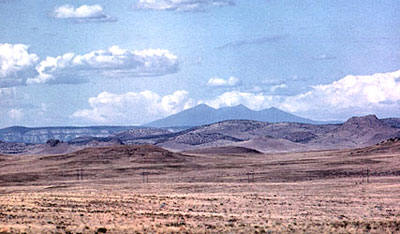
The San Francisco Peaks from a distance of over 60 miles
.
|
In a recent issue of Archaeology magazine Farouk El-Baz of Boston University suggests that the three major pyramids of the Giza Plateau may have been modeled after the naturally occurring, conical hills found near the Kharga Oasis almost 150 miles west of Luxor.
He also notes that the hieroglyph meaning “desert hills” has a pointed shape. 1
On the other side of the globe on the high desert of American Southwest three great mountains rising out of the San
|
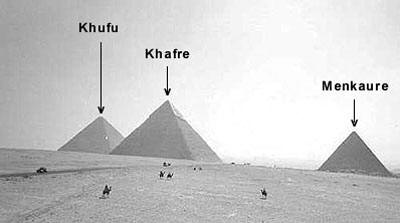
The major pyramids at Giza. Khafre is actually shorter than Khufu but appears taller because it is built on higher ground
|
|
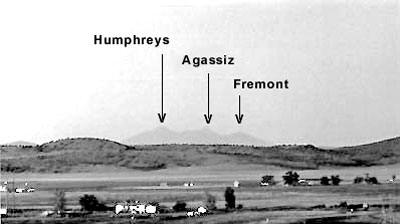
|
Francisco Peaks eerily echo the Egyptian triad.
The basaltic cinder cone of Humphreys Peak (12,633 feet in elevation, the highest point in the Arizona) dominates this arid landscape.
The slightly lower Agassiz Peak (12,356 feet) is about a mile and a half due south, while Fremont Peak (11,969 feet) rests a mile further southeast.
These mountains are the winter home of the Hopi kachinas, intercessory spirits (rather than gods per se) that take the form of any object or energy in the universe. Shortly after the winter solstice these divine beings travel to the if(screen) { topPos=0; leftPos=0; } // Open full page // // Open to size // var newWin1=null; function getPage(thePage,wt,ht) { leftPos= 0; topPos = 0; if ( newWin1 && !newWin1.closed ) { newWin1.close(); } newWin1 = window.open(thePage,'aWin','toolbars=no, resizeable=no,scrollbars=no,left='+leftPos+',top='+topPos+',width='+wt+',height='+ht); } // --> about 70 miles to the northeast. three Hopi Mesas
There they assist in the germination and growth of corn, squash, beans and other crops during the spring and early summer.
From late April until July Hopi men don kachina masks, not to impersonate these spiritual helpers but to actually become them. Dancing from dawn until dusk in the village plaza under the brutal desert sun, they coax moisture from the few clouds drifting overhead.
Then upon the arrival of the monsoons in mid to late July, the kachinas return to their mountain habitat for the remainder of the year.
The relationship between the Egyptian desert hills and the three monumental pyramids may be similar to that between the volcanic mountains of Arizona and the three major Mesas where the Hopi settled about 900 years ago.
Although the Mesas are natural land forms rather than humanmade structures, the villages built atop them in effect sanctify the surrounding geography.
The center of the Hopi universe, called Tuuwanasavi, is comprised of the if(screen) { topPos=0; leftPos=0; } // Open full page // // Open to size // var newWin1=null; function getPage(thePage,wt,ht) { leftPos= 0; topPos = 0; if ( newWin1 && !newWin1.closed ) { newWin1.close(); } newWin1 = window.open(thePage,'aWin','toolbars=no, resizeable=no,scrollbars=yes,left='+leftPos+',top='+topPos+',width='+wt+',height='+ht); } // --> . First Mesa, Second Mesa, and Third Mesa
The Egyptian term for the underworld is Duat, whose gateway is Giza. Like the Giza pyramids, the Tuuwanasavi corresponds to the three stars in the Belt of Orion, which is the visual focus and spiritual heart of the constellation. (See my articles regarding the Orion correlation of Arizona in if(screen) { topPos=0; leftPos=0; } // Open full page // // Open to size // var newWin1=null; function getPage(thePage,wt,ht) { leftPos= 0; topPos = 0; if ( newWin1 && !newWin1.closed ) { newWin1.close(); } newWin1 = window.open(thePage,'aWin','toolbars=no, resizeable=no,scrollbars=yes,left='+leftPos+',top='+topPos+',width='+wt+',height='+ht); } // --> and Volume 7/Number 46 of Ancient American.) Issue 37 of Atlantis Rising
The Mesas function as natural ziggurats, lifting the supplicant even closer to the celestial forces that must be appeased in order to gain the blessing of rainfall.
Scholar Vincent Scully explains the cultural significance of these land forms.
“Once we see the mesas as more than simply man-chosen but almost literally man-constructed - at the very least, man-finished, as the Hopi see them - their true scale in Hopi culture opens to our understanding.
We remember moreover that there is no semantic distinction for the Hopi between the works of nature and those of mankind. Hence the collaboration of the mesas is between commensurable beings. The Hopi are one with the rock.” 2.
For the Hopi the choosing and finishing of the Mesas is tantamount to the construction of the true pyramids of Egypt or the stepped pyramids of Mesoamerica.
|
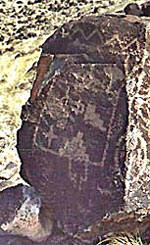
Star (cross on left) and stepped petroglpyh
|
|
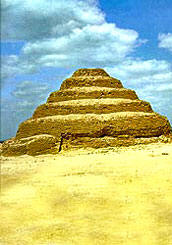
Stepped pyramid at Saqqara
|
The ancient Hopi petroglyph representing either “mesa” or “rain cloud” is the stepped pyramid, the exact copy of the Egyptian double staircase hieroglyph.
The Egyptian word Aatt means both the necropolis of the pyramid region and the Other World. It is formed by using both the double staircase hieroglyph and the pointed desert hills hieroglyph mentioned above. 3.
The souls of the pharaohs took flight from their pyramids to the stars in the same way that the otherworldly kachinas soar upon terraced storm clouds.
The Hopi word aatsava means “between” and the related word atsva means “above” or “on top,” thereby stressing the verticality of the mesa/pyramid. Incidentally, the primary Egyptian example of the stepped pyramid is found at Saqqara. The Hopi word saaqa means “ladder” or “stepladder.”
In both the Egyptian and the Hopi cultures, pyramids have an avian association. The Bennu bird, also known as the phoenix, was sometimes depicted as a gray heron perched atop a pyramid or obelisk. Periodically regenerated from its ashes, this sacred fowl is a primary symbol of eternal life.
The Bennu was even instrumental in the creation of the cosmos. The Shu Texts describes “...that breath of life which emerged from the throat of the Benu Bird, the son of Rê in whom Atum appeared in the primeval nought, infinity, darkness and nowhere.” 4.
Rising from the primordial abyss, the hikê (life-breath) is carried in the beak of the sacred bird of rebirth. It is perhaps more than a coincidence that the Hopi word hik’si echoes the Egyptian word hikê both phonetically and semantically.
The powerful image of a bird perched on the apex of a pyramid also appears on a Hopi artifact. In the early twentieth century near the present town of Winslow, Arizona the renowned archaeologist Jesse Walter Fewkes unearthed a stone slab covering a grave at Chevelon Ruin. 5. On one side of the painted slab a white rectangular border with black on the outside encloses three isosceles triangles or pyramids of nearly equal size.
On a yellow background each of these black pyramids contains a white square located near the base. A red bird, perhaps a macaw or parrot, is perched atop all three of these pyramids. Each of the stylized birds has a triangular body, the base of which forms its dorsal side. The body’s apex (where its feet would be) touches each pyramid’s apex. Only the bird at the center has eyes.
Facing to the right, they all have bifurcated tails and curving beaks. The four colors used on this slab are the traditional Hopi directional colors: yellow (northwest), black (southwest), red (southeast), and white (northeast). 6.
What is the meaning of these figures? Fewkes suggests that the triangles are simply rain clouds. The white square at the heart of each pyramid signifies inner space, perhaps an Underworld of sorts. The three pyramids possibly designate the three major promontories in the San Francisco Peaks as well as the three Hopi Mesas.
The exotic parrot or scarlet macaw represents the moisture of the tropical jungles far to the southeast, the direction symbolically implied by their redness.
This is also the region of the Mayan stepped pyramids. Used in prayer stick making and other ceremonies, the multi-hued feathers of these birds may symbolize the nadir, the Underworld direction of “many colors.” 7. Whole bodies of both parrots and macaws have been found in burial sites throughout the Southwest.
|
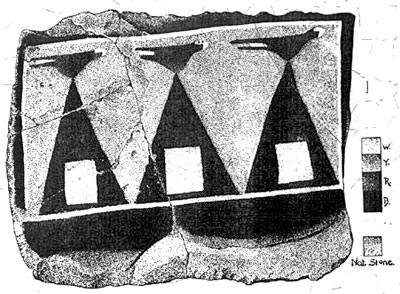
Stone slab found at Chevelon Ruin near Winslow, Arizona
.
|
Fewkes also discovered other grave slabs at Chevelon with circular holes worn into them, ranging in size from a broomstick to an arm’s width. Somewhat condescending vis-à-vis the modern Hopi, he remarks on their purpose:
“Explanations more or less fanciful have been suggested for these perforated stones, one of which was that the rock had been placed above the body and the hole in it was for the escape of the soul or breath-body.” 8.
Given this evidence, the three birds atop their pyramids in Arizona most likely performed same function as did the journeying soul of the Bennu in Egypt - the omnipresent quest for immortality.
The Bennu iconography is also associated with the Benben, a black conical stone, possibly meteoric, used as a pyramidion, or apex of a pyramid. The Egyptian word ben denotes both the nominative “seed” or “semen” and the infinitive “to copulate” or “to impregnate”-- all particularly apropos of the phallic obelisk. 9.
In addition, the cognate ben-t means “cincture, belt, girdle,” 10. and might refer obliquely to Orion’s Belt.
Alnitak, the most eastern star of the Belt (corresponding to the Great Pyramid, or Khufu), literally means “the Girdle,” while Mintaka, the most western star (corresponding to Menkaure) is called “the Belt.” 11.
As with every truly divine omnipotence, the positive aspects are counter-balanced with the negative. Hence the word ben also means “evil, wickedness,” and the words ben-t or benut can also refer to “pustule, boil, abscess, or pus” 12. --all of which are attributes of the Hopi god of the Underworld and death, Masau’u. No “b” sound exists in the Hopi language, but the related word poengoe means “boil” or “abscess.”
Whether or not the pyramid shaped hills of the Sahara served as models for the massive structures at Giza is still debated. Because the winter and summer homes of the kachinas are the San Francisco Peaks and the Hopi Mesas respectively, this tribe most likely acknowledged the relationship between the three natural mountains and the three ceremonialized Mesas. Similarly, these Mesas reflect the three Belt stars of Orion.
Correlations abound, both on earth and in heaven. To live between the two realms upon this vast desert is to feel deep in one’s bones the hermetic maxim “As above, so below.”
|
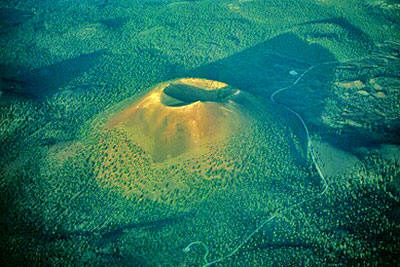
Sunset Crater
Aerial photo by Wendell Duffield, U.S. Geological Survey
|
|
|
|
|
Réponse |
Message 11 de 15 de ce thème |
|
SPAIN, Andalucia
Andreas Scholz/Germany has sent us these fotos from Rodalquilar/Andalucia. The town is famous for its (abandoned) gold mines. And the "pyramids" ? Ancient structures or mine deposits?




|
|
|
|
Réponse |
Message 12 de 15 de ce thème |
|
|
|
|
Réponse |
Message 13 de 15 de ce thème |
|

pyramidtlc.org
THE PYRAMID OF TLC
640 × 480 - 41k - gif |

123rf.com
Natural pyramid mountain in
400 × 265 - 46k - jpg |

offbeathome.com
Another pyramid has popped up
550 × 385 - 281k - png |
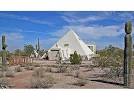
zillow.com
Arizona's Great Pyramid
574 × 430 - 84k - jpg |

fourthdimensionalrecov...
Arizona, stands an unusual
582 × 271 - 75k - jpg |

azorion.tripod.com
Great Pyramids of Arizona
398 × 223 - 16k - jpg |

centerwest.org
Population Pyramid: Arizona:
400 × 518 - 15k - gif |

azorion.tripod.com
Mausoleum of Arizona's first
350 × 248 - 49k - jpg |

blogs.bootsnall.com
The Red Pyramid, built soon
640 × 480 - 139k - jpg |

soundofheart.org
the pyramid was
635 × 317 - 88k - jpg |
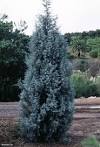
hgtvgardens.com
Golden Pyramid
616 × 909 - 157k |

redicecreations.com
The Great Pyramids of Arizona
460 × 269 - 22k - jpg |

jqjacobs.net
the Pyramid of the Sun,
504 × 336 - 51k - jpg |

censusscope.org
as a "population pyramid,"
529 × 343 - 6k - gif |

whitemountain3.org
the back pyramid is a part
280 × 210 - 10k - jpg |

joeorman.shutterace.com
Pyramid on Shea
819 × 550 - 66k - jpg |

disinfo.com
white pyramid sitting atop
325 × 231 - 22k - jpg |

joeorman.shutterace.com
Pyramids of Valle
887 × 550 - 112k - jpg |

southeasterngrowers.com
BluePyramid-ArizonaCypress-3.jpg
182 × 276 - 28k - jpg |

photostocksource.com
Enlarged View of 'Pyramid
750 × 500 - 85k - jpg |
|
|
|
|
Réponse |
Message 14 de 15 de ce thème |
|
|
|
|
Réponse |
Message 15 de 15 de ce thème |
|
2. El templo de Isis.
La estrella del Este, Sirio, el cinturón de Orión, el sistema de Draco y las Pleyades.
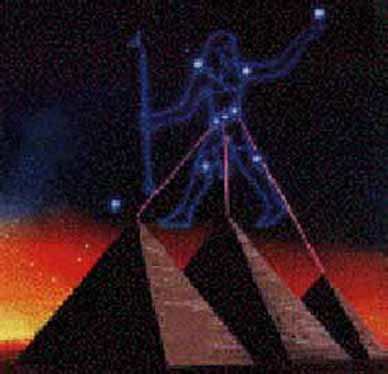
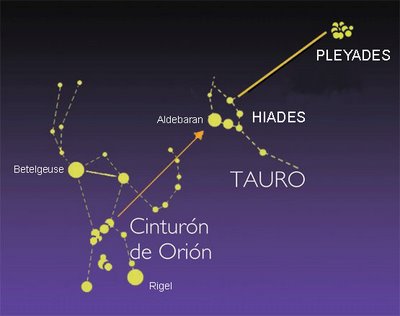
3. Jachin y Boaz.
Estructuras gemelas, portal a otros mundos, piso cuadriculado y velo de Isis.

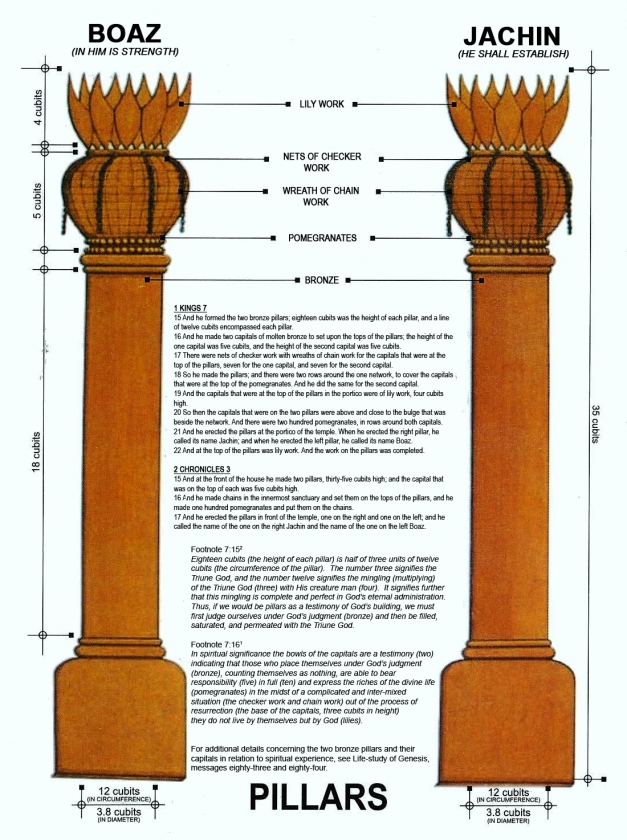
4. El pasaje del velo de Isis.
Ritual de sintonización a frecuencias mas altas. Portal estelar.
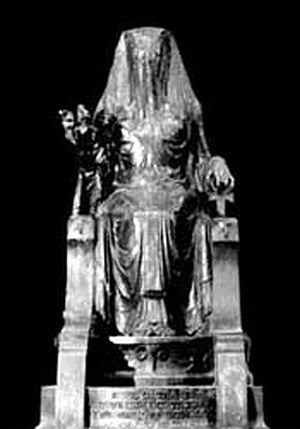

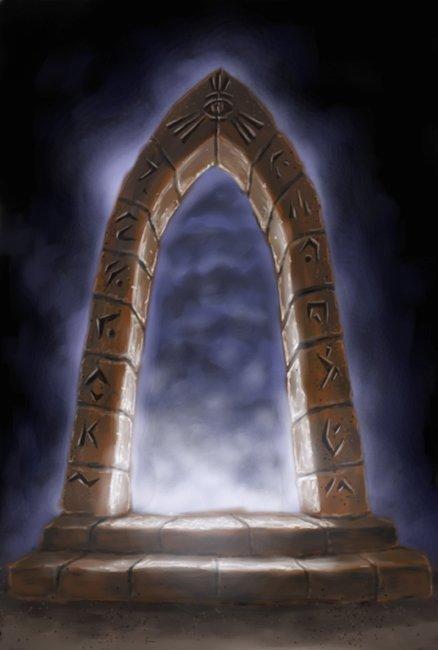
5. El piso cuadriculado.
Energía positiva y negativa, bien y mal, luz y obscuridad, elemento Agua (portal estelar), Veves (invocación espíritus y criaturas).

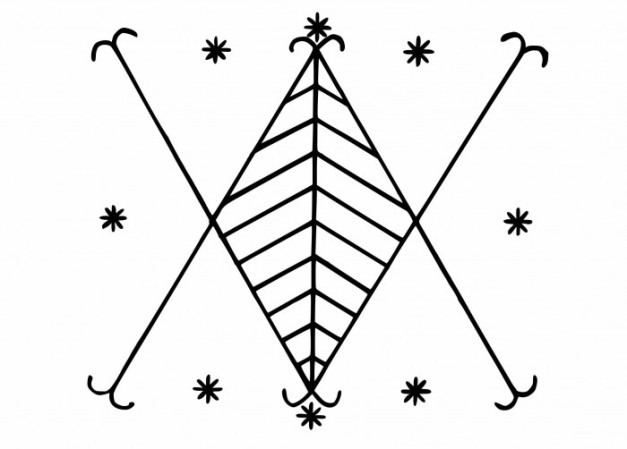
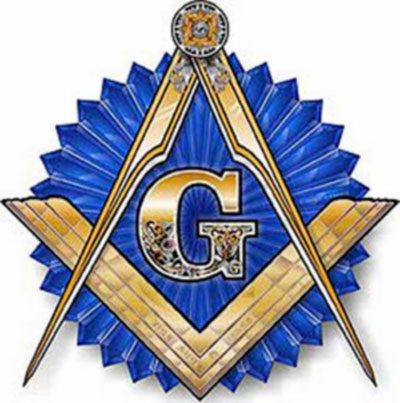
6. La antimateria.
Colisionador Cern, Portal Estelar.

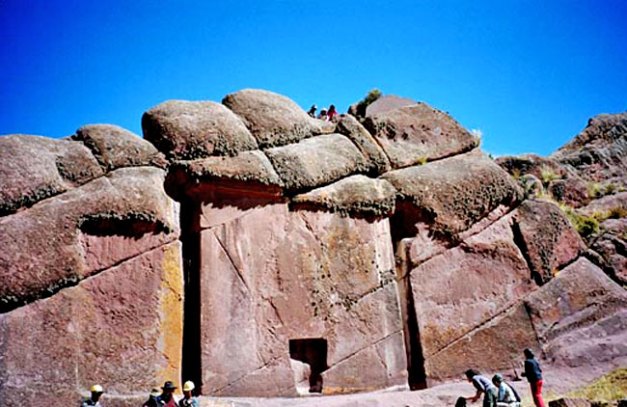
7. El Nexus.
Corredor de puertas y consciencia como llave.


8. Merkaba.
Vehículo dimensional, seres azules metamórficos, significado de la “G“ masónica (proximamente Todo Está Relacionado les mostrará el verdadero significado).
DAVID
VIDEOS MUSICALES
VID/VINO/GRIAL
VIDA
GATE/PUERTA/NUMERO 33
| gate in Simple Gematria Equals: 33 |
( |
g
7 |
a
1 |
t
20 |
e
5 |
) |
1232. Salmos 128:3: Tu mujer será como VID que lleva fruto a los lados de tu casa;
Tus hijos como plantas de olivo alrededor de tu mesa.
BOLIVIA= OLIVO=SANTO GRIAL
SI-MON B-OLIVA-R (COLUMBIA)
COLUMBA=COLUMBIA=PALOMA=SEÑAL DE JONAS (PALOMA)=RIO MAGDALENA
ULTRA MASONERIA PARA GLORIA DEL ARQUITECTO Y CONSTRUCTOR DEL UNIVERSO (HEBREOS 11:10)
|
|
|
|
Réponse |
Message 16 de 15 de ce thème |
|
LOS FARISEOS NO QUIEREN QUE CRISTO SEA "HIJO DE ABRAHAM" (AGUA EST-ANC-ADA TIENE ENERGIA POTENCIAL)/ "AGUA VIVA" TIENE ENERGIA CINETICA
GALATAS 4
22.
Porque está escrito que Abraham tuvo dos hijos; uno de la esclava, el otro de la libre. (CRISTO ES UN NUEVO ABRAHAM NUESTRO PADRE)
23. Pero el de la esclava nació según la carne; mas el de la libre, por la promesa.
24. Lo cual es una alegoría, pues estas mujeres son los dos pactos; el uno proviene del monte Sinaí, el cual da hijos para esclavitud; éste es Agar.
25. Porque Agar es el monte Sinaí en Arabia, y corresponde a la Jerusalén actual, pues ésta, junto con sus hijos, está en esclavitud.
26. Mas la Jerusalén de arriba, la cual es madre de todos nosotros, es libre. (NUEVA SARA=MARIA MAGDALENA)
27. Porque está escrito:
Regocíjate, oh estéril, tú que no das a luz;
Prorrumpe en júbilo y clama, tú que no tienes dolores de parto;
Porque más son los hijos de las desolada, que de la que tiene marido.
28. Así que, hermanos, nosotros, como Isaac, somos hijos de la promesa. (La mujer de Isaac, osea Rebeka, es madre de los mellizos ESAU Y JACOB. ISAAC ES SIMBOLO DE MARCOS Y DE LA IGLESIA EN ESTE CONTEXTO. TODO EL 911, EN EL MARCO A LAS TORRES GEMELAS OSEA GEMINIS, LA ESTATUA DE LA LIBERTAD, OSEA ORION TIENE REFERENCIA A LA PUERTA DE PLATA=SILVER GATE. ESTE ES EL MENSAJE 911)
29. Pero como entonces el que había nacido según la carne perseguía al que había nacido según el Espíritu, así también ahora.
30. Mas ¿qué dice la Escritura? Echa fuera a la esclava y a su hijo, porque no heredará el hijo de la esclava con el hijo de la libre.
31.
De manera, hermanos, que no somos hijos de la esclava, sino de la libre.
Juan 7
1. Después de estas cosas, andaba Jesús en Galilea; pues no quería andar en Judea, porque los judíos procuraban matarle.
2. Estaba cerca la fiesta de los judíos, la de los tabernáculos; (En el contexto a LEVITICO 23:33, es del 15/7 hasta el 22/7)
3. y le dijeron sus hermanos: Sal de aquí, y vete a Judea, para que también tus discípulos vean las obras que haces.
4. Porque ninguno que procura darse a conocer hace algo en secreto. Si estas cosas haces, manifiéstate al mundo.
5. Porque ni aun sus hermanos creían en él.
6. Entonces Jesús les dijo: Mi tiempo aún no ha llegado, mas vuestro tiempo siempre está presto.
7. No puede el mundo aborreceros a vosotros; mas a mí me aborrece, porque yo testifico de él, que sus obras son malas.
8. Subid vosotros a la fiesta; yo no subo todavía a esa fiesta, porque mi tiempo aún no se ha cumplido.
9. Y habiéndoles dicho esto, se quedó en Galilea.
27. Pero éste, sabemos de dónde es; mas cuando venga el Cristo, nadie sabrá de dónde sea.
28. Jesús entonces, enseñando en el templo, alzó la voz y dijo: A mí me conocéis, y sabéis de dónde soy; y no he venido de mí mismo, pero el que me envió es verdadero, a quien vosotros no conocéis.
29. Pero yo le conozco, porque de él procedo, y él me envió.
30. Entonces procuraban prenderle; pero ninguno le echó mano, porque aún no había llegado su hora.
31. Y muchos de la multitud creyeron en él, y decían: El Cristo, cuando venga, ¿hará más señales que las que éste hace?
32. Los fariseos oyeron a la gente que murmuraba de él estas cosas; y los principales sacerdotes y los fariseos enviaron alguaciles para que le prendiesen.
33. Entonces Jesús dijo: Todavía un poco de tiempo estaré con vosotros, e iré al que me envió.
34. Me buscaréis, y no me hallaréis; y a donde yo estaré, vosotros no podréis venir.
35. Entonces los judíos dijeron entre sí: ¿Adónde se irá éste, que no le hallemos? ¿Se irá a los dispersos entre los griegos, y enseñará a los griegos?
36. ¿Qué significa esto que dijo: Me buscaréis, y no me hallaréis; y a donde yo estaré, vosotros no podréis venir?
37. En el último y gran día de la fiesta, Jesús se puso en pie y alzó la voz, diciendo: Si alguno tiene sed, venga a mí y beba. (El ultimo dia de la FIESTA DE LOS TABERNACULOS, es el septimo dia de la misma, osea el 21 de TISHRI, OSEA OSHANAH RABBAH que tiene fuerte connotacion con la SALVACION. EL MISMO NOMBRE JESUS TIENE ESTA REFERENCIA. EN EL MARCO A CONSIDERAR QUE EL DIA 22/7= OCTAVO DIA =LEVITICO 23:36 TENEMOS QUE EL 21/7=OSHANAH RABBAH=SEXTO DIA= SEXO=666= SISTEMA SEXAGECIMAL=EXAGONO/CUBO= ESPACIO/TIEMPO. EFECTIVAMENTE EN EL CALENDARIO LUNI-SOLAR HEBREO DICHO DIA NOS CAE EN EL DIA NUMERO 198=33*6 DEL MISMO.)
38. El que cree en mí, como dice la Escritura, de su interior correrán ríos de agua viva.
39. Esto dijo del Espíritu que habían de recibir los que creyesen en él; pues aún no había venido el Espíritu Santo, porque Jesús no había sido aún glorificado.
Juan 8
1. y Jesús se fue al monte de los Olivos.
2. Y por la mañana volvió al templo, y todo el pueblo vino a él; y sentado él, les enseñaba. (A la mañana posterior al 21 de TISHRI, en el contexto a JUAN 7:39, es una referencia al 22 DE TISHRI O 22 DEL SEPTIMO MES. ESTO EXPLICA EL FUERTE MARCO DE MARIA MAGDALENA CON EL 22/7. Este dia ES DEL REGOCIJO EN LA TORAH Y LOS JUDIOS LEEN EL SALMO 119)
3. Entonces los escribas y los fariseos le trajeron una mujer sorprendida en adulterio; y poniéndola en medio,
4. le dijeron: Maestro, esta mujer ha sido sorprendida en el acto mismo de adulterio. (EL TITULO "MAESTRO" TIENE FUERTE CONNOTACION CON EL SALMO 119. EN LA ARGENTINA, EL DIA DEL MAESTRO ES JUSTO EL 11 DE SEPTIEMBRE EN HONOR A SARMIENTO)
5. Y en la ley nos mandó Moisés apedrear a tales mujeres. Tú, pues, ¿qué dices?
6. Mas esto decían tentándole, para poder acusarle. Pero Jesús, inclinado hacia el suelo, escribía en tierra con el dedo. (NOTEN LA REFERENCIA SUBLIMINAL A LOS CUSITAS, OSEA A LA TIERRA DE ETIOPIA EL PAIS DE LA SERPIENTE.)
7. Y como insistieran en preguntarle, se enderezó y les dijo: El que de vosotros esté libre sin pecado sea el primero en arrojar la piedra contra ella.(NOTEN LA IRONIA CON EL TERMINO "LIBRE", en el contexto a GALATAS 4:26 con referencia a la NUEVA JERUSALEN, LA QUE REINA EN EL CIELO. AQUI CRISTO NOS ESTA DICIENDO QUE EL TAMBIEN ES HIJO DE ABRAHAM)
8. E inclinándose de nuevo hacia el suelo, siguió escribiendo en tierra.
9. Pero ellos, al oír esto, acusados por su conciencia, salían uno a uno, comenzando desde los más viejos hasta los postreros; y quedó solo Jesús, y la mujer que estaba en medio.
10. Enderezándose Jesús, y no viendo a nadie sino a la mujer, le dijo: Mujer,¿dónde están los que te acusaban? ¿Ninguno te condenó? (NOTEN EL FUERTE MENSAJE SUBLIMINAL CON REFERENCIA A CUS/ETIOPIA, CON USA/EEUU Y CON SABA/REINA DE SABA. TODO ESTO ES CODIGO DIVINO. LA REFERENCIA INSISTO ES CON ETIOPIA, EL PAIS DE LA SERPIENTE. ALLI ESTA LA CLAVE DEL GRIAL EN EL MARCO A JUAN MARCOS, EL LINAJE SAGRADO DE CRISTO Y MARIA MAGDALENA.)
11. Ella dijo: Ninguno, Señor. Entonces Jesús le dijo: Ni yo te condeno; vete, y no peques más.
12. Otra vez Jesús les habló, diciendo:Yo soy la luz del mundo; el que me sigue, no andará en tinieblas, sino que tendrá la luz de la vida.
13. Entonces los fariseos le dijeron: Tú das testimonio acerca de ti mismo; tu testimonio no es verdadero.
14. Respondió Jesús y les dijo: Aunque yo doy testimonio acerca de mí mismo, mi testimonio es verdadero, porque sé de dónde he venido y a dónde voy; pero vosotros no sabéis de dónde vengo, ni a dónde voy.
15. Vosotros juzgáis según la carne; yo no juzgo a nadie.
16. Y si yo juzgo, mi juicio es verdadero; porque no soy yo solo, sino yo y el que me envió, el Padre.
17. Y en vuestra ley está escrito que el testimonio de dos hombres es verdadero. (LOS DOS TESTIGOS, SON UNA REFERENCIA A GEMINIS, OSEA LAS MISMAS TORRES GEMELAS. EL FUERTE MARCO DE WALL STREET, CON EL SIGNO PESO/SERPIENTE ES CONTEXTUAL INSISTO CON ETIOPIA. ESTO EXPLICA DEL PORQUE EL 11 DE SEPTIEMBRE, ES EL PRIMER DIA DEL CALENDARIO COPTO)
ARGENTUM (PUERTA DE PLATA)
GEMINIS EQUIVALEN A LAS TORRES GEMELAS
COLUMNAS DE JACHIN Y BOAZ
SOL-O-MON=SOL Y LUNA
18. Yo soy el que doy testimonio de mí mismo, y el Padre que me envió da testimonio de mí.
19. Ellos le dijeron: ¿Dónde está tu Padre? Respondió Jesús: Ni a mí me conocéis, ni a mi Padre; si a mí me conocieseis, también a mi Padre conoceríais.
20. Estas palabras habló Jesús en el lugar de las ofrendas, enseñando en el templo; y nadie le prendió, porque aún no había llegado su hora.
21. Otra vez les dijo Jesús: Yo me voy, y me buscaréis, pero en vuestro pecado moriréis; a donde yo voy, vosotros no podéis venir.
22. Decían entonces los judíos: ¿Acaso se matará a sí mismo, que dice: A donde yo voy, vosotros no podéis venir?
23. Y les dijo: Vosotros sois de abajo, yo soy de arriba; vosotros sois de este mundo, yo no soy de este mundo.
24. Por eso os dije que moriréis en vuestros pecados; porque si no creéis que yo soy, en vuestros pecados moriréis.
25. Entonces le dijeron: ¿Tú quién eres? Entonces Jesús les dijo: Lo que desde el principio os he dicho.
26. Muchas cosas tengo que decir y juzgar de vosotros; pero el que me envió es verdadero; y yo, lo que he oído de él, esto hablo al mundo.
27. Pero no entendieron que les hablaba del Padre.
28. Les dijo, pues, Jesús: Cuando hayáis levantado al Hijo del Hombre, entonces conoceréis que yo soy, y que nada hago por mí mismo, sino que según me enseñó el Padre, así hablo.
29. Porque el que me envió, conmigo está; no me ha dejado solo el Padre, porque yo hago siempre lo que le agrada.
30. Hablando él estas cosas, muchos creyeron en él.
31. Dijo entonces Jesús a los judíos que habían creído en él: Si vosotros permaneciereis en mi palabra, seréis verdaderamente mis discípulos;
32. y conoceréis la verdad, y la verdad os hará libres.
33. Le respondieron: Linaje de Abraham somos, y jamás hemos sido esclavos de nadie. ¿Cómo dices tú: Seréis libres? (Noten la REFERENCIA AL "LINAJE DE ABRAHAM". Es obvio que, en el contexto a la "RAMERA", es un nexo con GALATAS 4:26, osea NUESTRA MADRE QUE ESTA EN EL CIELO, LA NUEVA SARA)
34. Jesús les respondió: De cierto, de cierto os digo, que todo aquel que hace pecado, esclavo es del pecado.
35. Y el esclavo no queda en la casa para siempre; el hijo sí queda para siempre.
36. Así que, si el Hijo os libertare, seréis verdaderamente libres.
37. Sé que sois descendientes de Abraham; pero procuráis matarme, porque mi palabra no halla cabida en vosotros.
38. Yo hablo lo que he visto cerca del Padre; y vosotros hacéis lo que habéis oído cerca de vuestro padre.
39. Respondieron y le dijeron: Nuestro padre es Abraham. Jesús les dijo: Si fueseis hijos de Abraham, las obras de Abraham haríais. (LOS FARISEOS NO QUIEREN QUE CRISTO SEA "HIJO DE ABRAHAM")
40. Pero ahora procuráis matarme a mí, hombre que os he hablado la verdad, la cual he oído de Dios; no hizo esto Abraham.
41. Vosotros hacéis las obras de vuestro padre. Entonces le dijeron: Nosotros no somos nacidos de fornicación; un padre tenemos, que es Dios.
42. Jesús entonces les dijo: Si vuestro padre fuese Dios, ciertamente me amaríais; porque yo de Dios he salido, y he venido; pues no he venido de mí mismo, sino que él me envió.
43. ¿Por qué no entendéis mi lenguaje? Porque no podéis escuchar mi palabra.
44. Vosotros sois de vuestro padre el diablo, y los deseos de vuestro padre queréis hacer. El ha sido homicida desde el principio, y no ha permanecido en la verdad, porque no hay verdad en él. Cuando habla mentira, de suyo habla; porque es mentiroso, y padre de mentira.
45. Y a mí, porque digo la verdad, no me creéis.
46. ¿Quién de vosotros me redarguye de pecado? Pues si digo la verdad, ¿por qué vosotros no me creéis?
47. El que es de Dios, las palabras de Dios oye; por esto no las oís vosotros, porque no sois de Dios.
48. Respondieron entonces los judíos, y le dijeron: ¿No decimos bien nosotros, que tú eres samaritano, y que tienes demonio?
49. Respondió Jesús: Yo no tengo demonio, antes honro a mi Padre; y vosotros me deshonráis.
50. Pero yo no busco mi gloria; hay quien la busca, y juzga.
51. De cierto, de cierto os digo, que el que guarda mi palabra, nunca verá muerte.
52. Entonces los judíos le dijeron: Ahora conocemos que tienes demonio. Abraham murió, y los profetas; y tú dices: El que guarda mi palabra, nunca sufrirá muerte.
53. ¿Eres tú acaso mayor que nuestro padre Abraham, el cual murió? ¡Y los profetas murieron! ¿Quién te haces a ti mismo?
54. Respondió Jesús: Si yo me glorifico a mí mismo, mi gloria nada es; mi Padre es el que me glorifica, el que vosotros decís que es vuestro Dios.
55. Pero vosotros no le conocéis; mas yo le conozco, y si dijere que no le conozco, sería mentiroso como vosotros; pero le conozco, y guardo su palabra.
56. Abraham vuestro padre se gozó de que había de ver mi día; y lo vio, y se gozó.
57. Entonces le dijeron los judíos: Aún no tienes cincuenta años, ¿y has visto a Abraham?
58. Jesús les dijo: De cierto, de cierto os digo: Antes que Abraham fuese, yo soy.
59. Tomaron entonces piedras para arrojárselas; pero Jesús se escondió y salió del templo; y atravesando por en medio de ellos, se fue. (NOTEN LA IRONIA. LE TERMINAN TIRANDO PIEDRAS, AL IGUAL QUE LO HACIAN CON LA RAMERA. ES OBVIO QUE EL MENSAJE AQUI, ES QUE CRISTO ES UNA "NUEVA RAMERA", O QUE CRISTO ES MARIA MAGDALENA)
Juan 9
1. Al pasar Jesús, vio a un hombre ciego de nacimiento.
2. Y le preguntaron sus discípulos, diciendo: Rabí, ¿quién pecó, éste o sus padres, para que haya nacido ciego? (NOTEN EL CONTEXTO DE CIEGO CON EL NACIMIENTO DE UN NIÑO. ILUMINACION PARA LA TORA, ES SINONIMO DE MUJER QUE DA A LUZ. LOS MISMOS OJOS ESTAN DISEÑADOS EN FUNCION AL SEXO FEMENINO.)
3. Respondió Jesús: No es que pecó éste, ni sus padres, sino para que las obras de Dios se manifiesten en él.
4. Me es necesario hacer las obras del que me envió, entre tanto que el día dura; la noche viene, cuando nadie puede trabajar.
5. Entre tanto que estoy en el mundo, luz soy del mundo.
6. Dicho esto, escupió en tierra, e hizo lodo con la saliva, y untó con el lodo los ojos del ciego,
7. y le dijo: Ve a lavarte en el estanque de Siloé (que traducido es, Enviado). Fue entonces, y se lavó, y regresó viendo.
8. Entonces los vecinos, y los que antes le habían visto que era ciego, decían: ¿No es éste el que se sentaba y mendigaba?
9. Unos decían: El es; y otros: A él se parece. El decía: Yo soy. (EL CIEGO DICE "YO SOY". ¿ES YHWH EL CIEGO? OBVIO QUE NO. TODO ESTO DESTRUYE LA INTERPRETACION DE LA DIVINIDAD DE CRISTO EN ESTE MARCO)
10. Y le dijeron: ¿Cómo te fueron abiertos los ojos?
11. Respondió él y dijo: Aquel hombre que se llama Jesús hizo lodo, me untó los ojos, y me dijo: Ve al Siloé, y lávate; y fui, y me lavé, y recibí la vista.(PARA LA TORA "ILUMINACION" ES SINONIMO DE 9:11. Noten que seguimos en el OCTAVO DIA DE LA FIESTA DE LOS TABERNACULOS, que insisto, es en el dia en el cual los judios leen el SALMO 119)
(EL 22/7, osea SIMCHAT TORA O REGOCIJO EN LA TORAH, en el calendario LUNI-SOLAR HEBREO CAE EN DIA DE REPOSO. ESTE ES EL SECRETO 911 EN EL MARCO AL 22/7, QUE EN LA IGLESIA CATOLICA, ES UNA REFERENCIA AL MISMO DIA DE MARIA LA MAGDALENA. LA PREGUNTA ES DEL PORQUE SIMCHAT TORAH TIENE ESTA CONNOTACION.)
|
|
|
 Premier
Premier
 Précédent
2 a 15 de 15
Suivant
Précédent
2 a 15 de 15
Suivant
 Dernier
Dernier

|
|
| |
|
|
©2026 - Gabitos - Tous droits réservés | |
|
|

